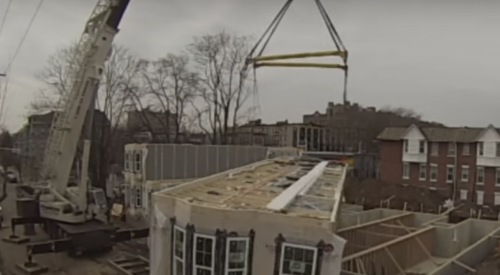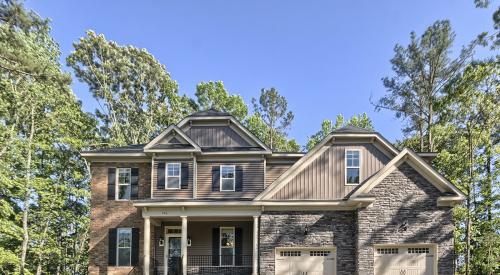| Don Bradley with one of his favorite building materials: a solar panel.
|
Don Bradley became interested in solar technologies long before he became a solar builder. While attending Santa Ana College in California for two years, an earth science teacher introduced the technical aspects to him. Class projects such as solar cookers and concentrators, along with field trips to such places as the Solar One Pilot Plant concentrating tower in nearby Barstow, peaked his interest.
The apartment complex where I lived out there even had solar hot water panels," says Bradley. ''That was the start of my interest, and I always tried to incorporate solar energy as a topic on all of my other class projects. I even drew up a complete business plan for a solar manufacturer for one of my marketing classes."
After moving back to Philadelphia and graduating from Drexel University, he was determined to work in the solar industry. He opened up the yellow pages and found the few solar companies in the area, then sent them his resume. He landed a job as a salesperson with a solar hot water system manufacturer, and moved up to become the company’s marketing manager.
"I used to call on a lot of builders with that job. I would explain that it is much less expensive to install these components during construction as opposed to retrofitting them," says Bradley. "Invariably, every builder I spoke with said they were not interested. Some were nicer than others were, some were forceful and some were downright belligerent. The more I understood how it could be implemented in residential construction, the more motivated I became to start my own solar home building business."
Thus he became President and Owner of Bradley Builders & Developers, Inc. in 1989, and has enjoyed many sunny days since.
PROFESSIONAL BUILDER: Have you seen the building industry change its attitude toward solar housing since you started your company?
I don’t have my fingers on the industry pulse like I used to, but there has been some change in attitudes. That may come from my own experience in attempting to contract some small to medium-sized builders to build my homes, and the success I’ve had so far. I think that builders have historically been reluctant to change, but they almost always do when their customers ask them. The fact is, there are more solar homes out there than ever before, so more people must be asking for solar homes and technologies. Another reason is the success of the Million Solar Roofs Initiative [the U.S. Dept. of Energy’s project to put one million solar energy systems on U.S. homes and buildings by 2010], which educates and encourages builders to incorporate solar technologies into their home plans.
Some mortgage companies are now even offering special 30-year mortgage programs for solar homes. Studies have shown that solar home residents tend to stay in their homes longer, they don’t sell as quickly or as often as owners of traditional homes do. Mortgage companies and lenders like that, because they don’t have to flip mortgages as often and it saves them money. But overall, I think there’s still a long way to go in changing some attitudes and getting more builders to incorporate solar.
What are some of the barriers to builder acceptance?
It’s still an education issue. There’s a lack of understanding as to what the technologies can do when installed properly during the construction phase, or there is a misinterpretation of the actual technologies involved.
Builders don’t know that there are three main categories of solar technologies: passive solar design, photovoltaics (which generate electricity) and solar hot water for domestic hot water usage. That misunderstanding is a key reason that builders don’t use it more. I also don’t think they realize that by building with solar, they could market a home that saves 50, 60, even 70% off a typical energy bill. If more builders fully understood that, more would be doing it.
Have consumers grown more accepting in recent years?
To a certain extent, yes. Mainly because of three things: environmental concerns, electric utility deregulation and rising energy costs. People understand some of the environmental issues better than they did 10 or so years ago. Most homebuyers are familiar with the terms greenhouse gases, acid rain and ozone depletion, and that those conditions are caused by burning fossil fuels. Solar energy technologies burn zero fuels, are zero polluting and alleviate those issues. Consumers are more knowledgeable and concerned, so they’re looking for alternatives, one of which is solar.
|
Deregulation is starting to have a bigger effect because up until recently, the electricity industry - for better or for worse - was a monopoly. Now the requirements break up the service territories and include millions of dollars to promote solar technologies as a viable alternative. Also, a spike in energy prices, such as the recent oil and gasoline price surges, always sparks the interest of potential homeowners.
How has this growing interest helped your business in its first 11 years?
I built two spec homes for my first project and sold them immediately. No one knew who I was or what I was doing, so I had to build spec homes. I got some publicity from some trade publications and the local press, and was asked to build more. I then received a grant from the Pennsylvania Energy Office that really got my name on the map as a solar builder. I began getting calls from all over the country and I then expanded [Bradley often offers his consulting services for urban low and moderate-income housing projects, sustainable community design, tract developments and commercial and institutional ventures].
What often happens is that I’ll build one home in an area, and then I’ll end up building another because people will drive by the project or friends and family members become interested. Word-of-mouth has been huge in building my business.
Is there any particular market segment that seems to be more interested in solar homes?
Not in my estimation, I’m seeing across-the-board interest. I’m building the full range of houses, from the 1400 square-foot inner-city rowhomes [an 18-unit solar townhouse project in southwest Philadelphia, which Bradley conceived and designed] to the ultra-expensive 5000 square-foot solar home on the absolute other end of the spectrum. The reason I’m able to do that is because the benefits are real for all homeowners, no matter the income level. The affordable market does benefit most because it reduces their energy bills by sixty to seventy percent. This type of energy savings makes a huge impact on their standard of living.
A common fear or reason for hesitation in including solar components is that they require more maintenance and upkeep. Is this the case?
No. Passive solar design requires zero maintenance because the key is site planning and orientation. In the past, builders thought that if they pointed all their houses south, they would lose lots. That’s incorrect, if you get into the early stages of planning, when the street layout in the subdivision is conceived, then no lots are lost.
Photovoltaics have no moving parts; the system needs as much maintenance as your home’s electrical main panel. I offer a standard 3-year warranty, the photovoltaic PV panels themselves are warranted for 20 years, inverters for 5 years. These are far longer than warranties for virtually every other component of a typical house.
What about having to climb up on a roof and clean solar panels?
Studies have been done that show the normal weather cycle - wind, rain and snow - cleans them sufficiently with no significant loss in efficiency. In extreme climates or conditions, you may have to clean them once in a great while. If you’re solely reliant on solar energy, then you may want to clean them better than those who are grid-interactive. For those solar homeowners who are still on the grid, the cost of going up and cleaning them is almost always more than the savings achieved by cleaning them.
You’ve chosen modular builders to construct your homes. How does that fit in with your solar interests?
First, there are virtually no design restrictions. I’ve been able to build every single floor plan that my customers bring to me. It gives me complete design flexibility. Modular housing has allowed me to expand my business to more areas, including Vermont, Cape Cod and New Jersey - basically up and down the East Coast.
It also allows me to offset the added cost of some of the solar components. Little things add up, such as no dumpster fees because I have very little jobsite waste, or minimal theft and vandalism because that house is under lock and key the first evening after it is set. I also save on labor because my cycle time is greatly reduced, which allows me to save on interest payments on my construction loans.
Plus modular manufacturers get volume discounts on materials that would not be available to me as a small builder and they pass that along. Those factors combine for a 5% to 7% cost reduction compared to a stick-built home. The solar technologies can add about 10% to 12% over a conventional home. That often leaves my solar homes at only 3% to 5% more expensive than conventional ones.
My customers often already know they want to buy a solar home, so they look at their options and amenities packages to offset the added solar component costs. They get the basic or less expensive choices and put those dollars into the solar components. That brings the total cost even closer to a conventional home. My customers usually come in at the same level or only 1% to 2% higher than a comparable home without solar technology. But their energy bills are reduced by nearly 70%.
Are those types of figures instrumental in your carving out a market niche?
Oh, absolutely. Solar housing is definitely a niche market and I’m doing very well in it. Other builders either aren’t comfortable with it, aren’t aware of it or aren’t capitalizing on it.












